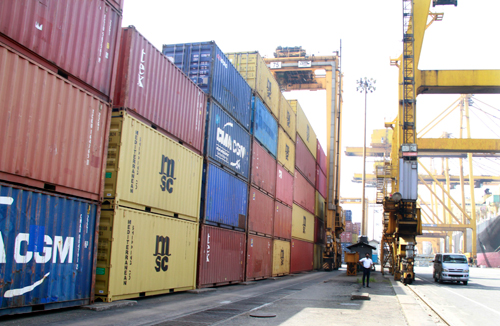Import controls, then and now!
View(s):
Import containers at the Colombo Port.
We, a few friends, gathered at Dharini’s home at the Bambalapitiya seaside for our Christmas lunch. I never thought that our friend, Christo would be telling us a half century-old story – the one that I am about to reveal to you – and that neither would I be writing it today at the beginning of a new year.
I used to call him Christo, because his name is Christopher Motha. Although we don’t often meet, our annual Christmas lunch is one of the occasions we don’t miss. When we met this time, it was only two weeks after Christo’s uncle – his father’s younger brother, had passed away at age 93. But his father, Delasalle Motha – the founder of Motha Confectionary Works, had passed away in the early 1990s at his age 61. As I asked him about the untimely death of his father at that age about 30 years ago, Christo spoke of his father’s business venture as well.
Delasalle Motha established the Motha Confectionery Works company in 1960 with his brother, located the factory in Colombo 13, provided jobs to about 30 employees and, catered to the domestic market. The business started flourishing in the 1960s with Delasalle’s entrepreneurship skills blended with his innovative business ideas in the confectionery industry.
It was “jelly” that became one of the most popular products of Motha Confectionery Works. The materials required for jelly – particularly, gelatin and essence, were supplied regularly through imports from the UK. Delasalle wanted to make sure that the inputs for his jelly should be of high quality and thus he didn’t want to import it from anywhere else other than the UK. Perhaps, it was the first time that this particular product with high quality jelly crystal was introduced to the Sri Lankan customers, or rather the Ceylonese customers, as far back as the 1960s.
Delasalle was a well-disciplined man with a healthy lifestyle and a good character. He had a family with three children, including our friend Christo. Delasalle was fond of playing tennis too; in the evening after work and customary would go to the club to play tennis. He did well in all affairs – his own business, his family matters and his personal life, until things began to change 10 years later.
The downfall
It was in 1970 when a “hard phase” of import controls and foreign exchange restrictions began to take their toll over economic affairs of the country. The country’s foreign debt had increased to over 15 per cent of GDP from less than 5 per cent in five years; the Central Bank’s foreign reserves had dropped to two months of imports from around 10 months in the mid-1950s.
 In response to the foreign exchange crisis, there were stringent controls over imports and over the release of foreign exchange from banks for business. Unlike today, it was not because the government had no choice, but because the government’s political economic ideology was in line with such an economic policy. The government also saw the “mini-liberalisation” attempt of the previous government which was a “waste of scarce foreign exchange” of the country. The newly-introduced controls did not reverse the misfortune of the Sri Lankan economy, but rather aggravated it further in the 1970s.
In response to the foreign exchange crisis, there were stringent controls over imports and over the release of foreign exchange from banks for business. Unlike today, it was not because the government had no choice, but because the government’s political economic ideology was in line with such an economic policy. The government also saw the “mini-liberalisation” attempt of the previous government which was a “waste of scarce foreign exchange” of the country. The newly-introduced controls did not reverse the misfortune of the Sri Lankan economy, but rather aggravated it further in the 1970s.
The operations of the Motha Confectionery Works company came to a halt, as Delasalle was unable import his raw materials for confectionery production. But he continued to pay the salaries of his employees; they came to work but stayed idling in the factory premises. Delasalle thought that the import controls and foreign exchange restrictions were temporary. He expected that they would soon be lifted, and he could import his raw materials and start production.
As usual, Delasalle used to go to the factory and walk around looking at machines that were idling and workers who were hanging around. Months became years and the government tightened the controls further. As time passed, he had to borrow money to pay the salaries. As years were extending further, he decided to lay off his employees for which he had to pay compensations with borrowed money. He was indebted and, didn’t know how to repay the loans. He continued to go to the club, but now it was not for playing tennis; he started drinking and became addicted to alcohol. Then, he fell into depression and his health condition deteriorated.
Foreign exchange crisis
The government reaction to the foreign exchange crisis is not unusual for us today. The Central Bank used its foreign reserves to mitigate the mounting pressure on the exchange rate; in fact, under the then “pegged” exchange rate system, it was an obligation of the Central Bank, although under today’s “floating” exchange rate it is not so.
As banks did not have enough foreign exchange and the Central Bank had restricted its permission to issue foreign exchange, there was a black market for foreign currency. If you were going abroad in the 1970s, your foreign exchange entitlement was limited to 3 pounds and 6 shillings! Imports had been categorised as “essential” and “non-essential or luxury” for the purpose of allowing only minimum imports to the country. Import controls were applied through high tariffs, import license, quota system and the foreign exchange restrictions.
Apart from import controls, the Central Bank maintained two different exchange rates as official and special rates, which was the so-called Foreign Exchange Entitlement Certificate (FEEC) scheme; the special rate was 45 per cent higher than the official rate, which was later raised to 65 per cent. This means that if you are importing “non-essential” items, the rate applied was higher; on the export side too, if you are exporting “non-traditional” items, you can claim the higher exchange rate. As such non-traditional exports (other than tea, rubber and coconut) were marginal, the government didn’t have to pay much under the special rate.
The government also introduced a Convertible Rupee Account (CRA) scheme for the exporters of non-traditional export commodities, allowing them to use 25 per cent of their foreign exchange earnings to finance restricted imports. While it was envisaged that this would encourage such exports, the other side of the scheme was that they must convert 75 per cent of their export earnings to rupees.
Since the late 1960s, the government adopted various policy measures to promote exports – particularly the so-called non-traditional exports – as well as even to encourage foreign direct investment (FDI). But they didn’t produce any substantial result; how could they? You cannot adopt export promotion and import substitution as a “half-and-half” policy!
Missed opportunity
The tragedy of Motha Confectionery Works was not a random event in the 1970s; it was just one example of a widespread foreign exchange crisis, converted by the government into an economic crisis. According to available evidence, the capacity utilisation in industry was around 60 – 65 per cent of total capacity in the industrial sector during 1968-77, because of the shortage of inputs. As a result, average rate of GDP growth remained less than 3 per cent during 1971-1977. Domestic supply shortage mounted due to both import controls and inadequate local production. As the economy did not expand enough to generate job opportunities to a growing population – mostly, the educated youth, unemployment rose to as high as 24 per cent of the labour force.
Although the hardship of the people was extensive, it was through that hardship that the country was prepared for a dramatic policy change in 1977. As a result, trade liberalisation took place overnight. But nevertheless, I think that this historical opportunity to bring about a better future for Sri Lanka was sadly missed.
Well what happened to Motha Confectionery Works? As a result of trade liberalisation, inputs to produce “jelly crystal” could be imported again. But it was too late as Delasalle was not in the right mind to revamp his company. It was his brother who made that attempt, while the company was later bought by another and continues to remain in business.
(The writer is a Professor of Economics at the University of Colombo and can be reached at sirimal@econ.cmb.ac.lk and follow on Twitter @SirimalAshoka).
Hitad.lk has you covered with quality used or brand new cars for sale that are budget friendly yet reliable! Now is the time to sell your old ride for something more attractive to today's modern automotive market demands. Browse through our selection of affordable options now on Hitad.lk before deciding on what will work best for you!


